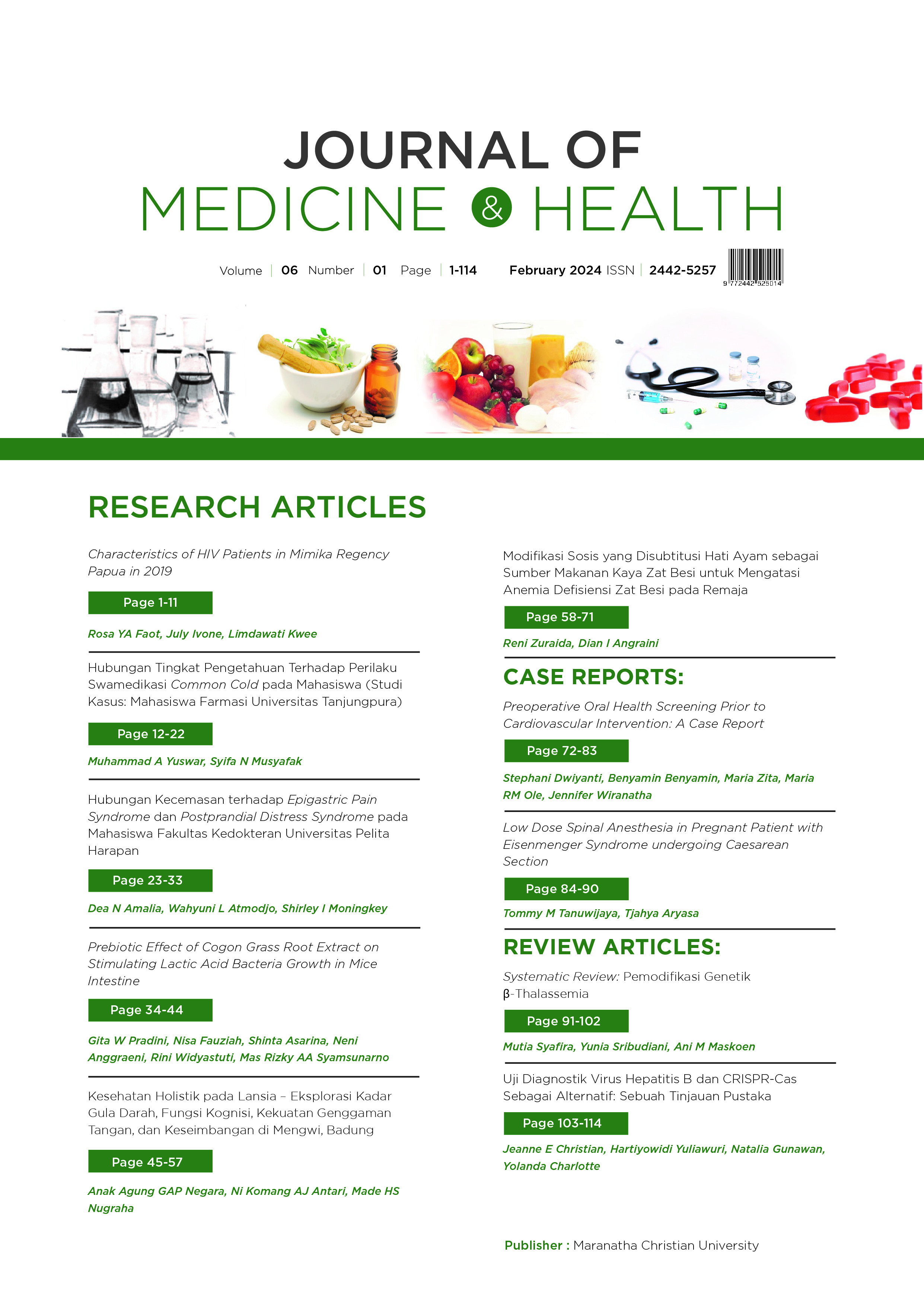Prebiotic Effect of Cogon Grass Root Extract on Stimulating Lactic Acid Bacteria Growth in Mice Intestine
DOI:
https://doi.org/10.28932/jmh.v6i1.7689Abstract
Lactic acid bacteria (LAB) are known for their numerous beneficial effects for health and their colonization within intestines is affected by prebiotic consumption. Cogon grass root is an herbal medicine which contain substantial quantities of polyphenols. Recently, many studies suggested polyphenols as a novel group of prebiotics. Therefore, this study aimed to explore prebiotic effect of cogon grass root extract (CGRE) on stimulating growth of LAB in mice intestine. Mice (n =7/group) were divided into three groups; group A (control), group B and C received CGRE orally with daily dosage 90 and 115mg/kg BW, respectively. After 14 days of treatment, all mice were sacrificed. LAB was isolated and counted from ileum. Additional biochemical tests were performed to confirm the bacteria as LAB. Further identification of representatives LAB was performed with API-CHL-50 System. We found increased growth and diversity of LAB in the treatment group with optimum growth stimulation at CGRE dosage 90mg/KgBW daily (group B). Further identification showed Lactococcus lactis was the most frequent LAB found in all groups, with additional Lactobacillus paracasei and Lactobacillus curvatus were found in the treatment group. These findings support additional benefit of CGRE as prebiotics by stimulating LAB growth and diversity in mice intestine.Downloads
References
Olvera-Rosales LB, Cruz-Guerrero AE, Ramirez-Moreno E, Quintero-Lira A, Contreras-Lopez E, Jaimez-Ordaz J, et al. Impact of the Gut Microbiota Balance on the Health-disease Relationship: The Importance of Consuming Probiotics and Prebiotics. Foods. 2021;10(6):1261.
Ding RX, Goh WR, Wu RN, Yue XQ, Luo X, Khine WWT, et al. Revisit Gut Microbiota and Its Impact on Human Health and Disease. JFDA. 2019;27(3):623-31.
Valdes AM, Walter J, Segal E, Spector TD. Role of the gut microbiota in nutrition and health. BMJ. 2018;361:36-44.
Lu S. The role of Lactic Acid Bacteria in Gut Microbiota and Mucosal Immune System. South Fla. 2021;2(3): 3918-25.
Qin D, Ma Y, Wang Y, Hou X, Yu L. Contribution of Lactobacilli on Intestinal Mucosal Barrier, and Diseases: Perspectives and Challenges of Lactobacillus casei. Life.2022;12(11):1910.
Dempsey E, Corr SC. Lactobacillus spp. for Gastrointestinal Health: Current and Future Perspectives. Front. Immunol. 2022;6(13):840245.
Donaldson GP, Lee SM, Mazmanian SK. Gut biogeography of the bacterial microbiota. Nat. Rev. Microbiol. 2015;14(1):20–32.
Nishiyama K, Sugiyama M, Mukai T. Adhesion properties of lactic acid bacteria on intestinal mucin. Microorganisms. 2016;4(3).
Wang S, Xiao Y, Tian F, Zhao J, Zhang H, Zhai Q, et al. Rational use of prebiotics for gut microbiota alterations: Specific bacterial phylotypes and related mechanisms. J. Funct. Foods. 2020; 66:103838.
Kaye DM, Shihata WA, Jama HA, Tsyganov K, Ziemann M, Kiriazis H, et al. Deficiency of Prebiotic Fiber and Insufficient Signaling Through Gut Metabolite-Sensing Receptors Leads to Cardiovascular Disease. Circulation. 2020;141(17):1393-403.
Pickard JM, Zeng MY, Caruso R, Nunez G. Gut microbiota: Role in pathogen colonization, immune responses, and inflammatory disease. Immunol. Rev. 2017;279(1):70–89.
Rodriguez-Daza MC, Pulido-Mateos EC, Lupien-Meilleur J, Guyonnet D., Desjardins Y, Roy D. Polyphenol-Mediated Gut Microbiota Modulation: Toward Prebiotics and Further. Front. Nutr. 2021;28(8):689456.
Gwiazdowska D, Jus K, Jasnowska-Malecka J, Kluczynska K. The Impact of Polyphenols on Bifidobacterium growth. Acta Biochim Pol. 2015;62(4):895–901
Plamada D, Vodnar DC. Polyphenols-gut microbiota interrelationship: A transition to a new generation of prebiotics. Nutrients. 2022;14(1):137.
Milutinovic M, Dimitrijevic-Brankovic S, Rajilic-Stojanovic M. Plant Extracts Rich in Polyphenols as Potent Modulators in the Growth of Probiotic and Pathogenic Intestinal Microorganisms. Front Nutr. 2021;30(8):688843.
de Souza EL, de Albuquerque TMR, dos Santos AS, Massa NML, de Brito Alves JL. Potential interactions among phenolic compounds and probiotics for mutual boosting of their health-promoting properties and food functionalities-A review. Crit. Rev. Food Sci Nutr. 2019;59(10):1645–59.
Abbas M, Saeed F, Anjum FM, Afzaal M, Tufail T, Bashir MS, et al. Natural polyphenols: An overview. Int. J Food Prop. 2017;20(8):1689–99.
Hano C, Tungmunnithum D. Plant Polyphenols, more than Just Simple Natural Antioxidants: Oxidative Stress, Aging and Age-Related Diseases. Medicines. 2020;7(5):26
Klinder A, Shen Q, Heppel S, Lovegrove JA, Rowland I, Tuohy KM. Impact of increasing fruit and vegetables and flavonoid intake on the human gut microbiota. Food Funct. 2016;7(4):1788–96.
Singh AK, Cabral C, Kumar R, Ganguly R, Rana HK, Gupta A, et al. Beneficial effects of dietary polyphenols on gut microbiota and strategies to improve delivery efficiency. Nutrients. 2019;11(9):2216.
Susanto AH, Dwiati M. Assessment of cogon grass (Imperata cylindrica (L.) P. beauv.) genetic variation in Java, Indonesia using atpB-rbcL and trnL-F intergenic spacer. Biodiversitas. 2022;23(5):2760-7.
Sytar O, Hemmerich I, Zivcak M, Rauh C,Brestic M. Comparative analysis of bioactive phenolic compounds composition from 26 medicinal plants. Saudi J. Biol. Sci. 2018;25(4):631–41.
Tungmunnithum D, Thongboonyou A, Pholboon A, Yangsabai A. Flavonoids and Other Phenolic Compounds from Medicinal Plants for Pharmaceutical and Medical Aspects: An Overview. Medicines. 2018;5(3):93.
Hidayat S, Rachmadiyanto AN. Utilization of Alang-Alang (Imperata cylindrica (L.) Raeusch.) as Traditional Medicine in Indonesian Archipelago. Proceedings The 1st SATREPS Conference. 2017; 1:82-89.
Indriyanti RA, Ariyanto EF, Usman HA, Effendy RR, Dhianawaty D. Quantification of total polyphenols and flavonoids, antioxidant activity, and Sinensetin and Imperatorin contents of Imperata cylindrica root ethanol extract. Pharmacogn J. 2022;14(4):327–37.
Anggraeni N, Syamsunarno MRAA, Mukarromah GR, Zada A, Triatin RD, Pamela Y, et al. Low Serum Cholesterol in Mice Pre-treated with Imperata cylindrica (L.) after Acute Olive Oil Gavage. KnE Life Sci. 2017;3(6):460.
Arifin WN, Zahiruddin WM. Sample size calculation in animal studies using resource equation approach. Malays J Med Sci. 2017;24(5):101–5.
Bayu HH, Isolation and Identification of Lactic Acid Bacteria from Channa sp. as Potential Probiotic. Jurnal Pembelajaran dan Biologi Nukleus. 2023;9(1):75-84.
Mejia-Gomez CE, Balcazar N., Isolation, characterisation and continuous culture of Lactobacillus spp. and its potential use for lactic acid production from whey. Food Sci. Technol. 2020;40(4):1-8.
Ni K, Wang Y, Li D, Cai Y, Pang H. Characterization, identification, and application of lactic acid bacteria isolated from forage paddy rice silage. PLoS One. 2015;10(3):e0121967.
Elias-Oliveira J, Leite JA, Pereira IS, Guimaraes JB, Manso GM da C, Silva JS, et al. NLR and Intestinal Dysbiosis-Associated Inflammatory Illness: Drivers or Dampers? Front Immunol. 2020;11(11):1810.
Holscher HD. Dietary fiber and prebiotics and the gastrointestinal microbiota. Gut Microbes. 2017;8(2):172–84
Moreno-Indias I, Sanchez-Alcoholado L, Perez-Martínez P, Andres-Lacueva C, Cardona F, Tinahones F, et al. Red wine polyphenols modulate fecal microbiota and reduce markers of the metabolic syndrome in obese patients. Food Funct. 2016;7(4):1775–87
Moorthy M, Sundralingam U, Palanisamy UD. Polyphenols as prebiotics in the management of high-fat diet-induced obesity: A systematic review of animal studies. Foods. 2021;10:299
Hakim BNA, Xuan NJ, Oslan SNH. A Comprehensive Review of Bioactive Compounds from Lactic Acid Bacteria: Potential Functions as Functional Food in Dietetics and the Food Industry. Foods. 2023;12(15):2850.
Chan CL, Gan RY, Shah NP, Corke H. Polyphenols from selected dietary spices and medicinal herbs differentially affect common food-borne pathogenic bacteria and lactic acid bacteria. Food Control. 2018;92:437–43.
dos Santos AS, de Albuquerque TMR, de Brito Alves JL, de Souza EL. Effects of Quercetin and Resveratrol on in vitro Properties Related to the Functionality of Potentially Probiotic Lactobacillus Strains. Front. Microbiol. 2019;10:2229.
Nayim P., Mbaveng AT., Sudhir K., Wamba BEN., Sanjukta M., et al. Phytochemistry and pharmacology of Imperata cylindrica: A comprehensive review. Invest Med Chem Pharmacol.2023;6(1):76
Rosnizar R., Muliani F., Ramli IM., Eriani K. The Immunostimulant Effects of Alang-Alang (Imperata cylindrica) Roots Extract on BALB/c Male Mice (Mus musculus). Adv. Biol. Sci. Res. 2022;22
Alvarez-Mercado AI., Plaza-Diaz J. Dietary Polysaccharides as Modulators of the Gut Microbiota Ecosystem: An Update on Their Impact on Health. Nutrients 2022;14(19):4116
Downloads
Published
How to Cite
Issue
Section
License
Copyright (c) 2024 Gita W Pradini, Nisa Fauziah, Shinta Asarina, Neni Anggareni, Rini Widyastuti, Mas Rizky AA Syamsunarno

This work is licensed under a Creative Commons Attribution-NonCommercial 4.0 International License.
Authors who publish with this journal agree to the following terms:
- Authors retain the copyright and grant the journal right of first publication with the work
simultaneously licensed under a Creative Commons Attribution-NonCommercial 4.0 International License that allows others to share the work with an acknowledgement of the work's authorship and initial publication in this journal. - Authors are able to enter into separate, additional contractual arrangements for the nonexclusive distribution of the journal's published version of the work (e.g., post it to an institutional repository or publish it in a book), with an acknowledgement of its initial publication in this journal.
 This work is licensed under a Creative Commons Attribution-NonCommercial 4.0 International License.
This work is licensed under a Creative Commons Attribution-NonCommercial 4.0 International License.

















